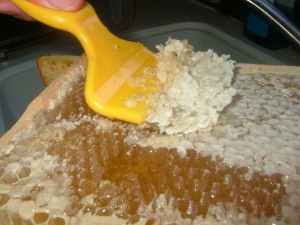With the hives filling very rapidly this year and the bees getting ready to swarm it seemed logical to give the bees back some space and take off the first honey crop of the year. Each of my three main hives had two supers full of ‘capped’ frames with the honey ready to extract.
The bees cap the honey comb once the water content of the honey has been reduced to less than 19% and there is no risk of it being able to ferment. Due to the size of the colonies I only remove one super from each hive at a time to retain the bees space inside the hive, rather than taking two in one go and condensing the bees down into a smaller space during the very hot weather which may then encorage them to swarm earlier than normal.
I attended the apiary on the Friday evening and placed clearer boards with porter bee escapes in the hive under the honey super containing the frames to be extracted. The bee escapes are really bee turnstiles, as in they let the bees out of the honey super to be removed but not back in again. You have to be careful that you leave no bee space into the super to be removed as once the bees are out it is very easy for robbing to take place and all your honey crop can disappear in a day!
Returning on a very warm Sunday morning I wasn’t sure how well the clearing would have worked as last year it wasn’t that successful but this year it seemed to have worked far better, maybe this was due to the hives being taller with more hive space beneath and the clearer boards being in place for longer or maybe it was just due to the unseasonal heat. The full supers were swiftly removed and the few lingering bees guarding the frames of honey were gently encouraged to return to the hive. There is little more off putting then a few bees flying around your head whilst you try to extract the stolen honey!
With bees and honey separated it was time to spin out the honey. The wax capping that seal the honey in the comb are removed using an ‘uncapping fork’ and the frames are then placed in a centrifugal device that allows you to gently spin out the honey, then reverse the frames and repeat this process until the combs are virtually empty.
There will always be traces of honey left in the comb and a little ‘set’ honey and this will be fed back to the bees who will clean it from the ‘wet comb’ and take the honey back down deeper into the hive. Once the frames are cleaned and dry they will be removed and stored until required again.
Once the honey has been removed from the comb it is allowed to pass through a coarse filter and then a very fine filter to remove some of the wax particles, pollen and anything else that may have made its way into the honey. This seems to be the longest part of the extraction process with the honey slowly dripping through the filters.
Following the extraction and filtering it is allowed to settle for at least 24 hours, this is allow any air bubbles introduced whilst spinning it out of the frames to rise to the surface. There is nothing wrong with these appearing in the honey but cosmetically it it better to lose them. The honey is then literally passed through quality control (tasted for sweetness!) and ‘poured off’ through the honey tap into the sterilised jars and labelled up ready for sale.
The cappings contain a fair amount of honey and these are separated from the wax in warm water – this will now form the sugary syrup that will be the base for making this year’s honey mead – and probably form the subject of my next blog entry!









Posted by eanjewellery on July 5, 2011 at 7:09 am
I’m glad to see you have good QA/QC procedures with you honey production ! ;o)
Posted by danieljmarsh on July 5, 2011 at 7:53 pm
it’s good to have a taster with an unspoilt palate, the wine box next to the honey tank was for me not Jude!
Posted by Rob Naylor on July 23, 2011 at 2:06 pm
And very good honey it is, too, Dan.
Problem is…I’m consuming it too quickly 😦
Posted by danieljmarsh on July 23, 2011 at 7:32 pm
Glad you are enjoying it and good idea to stock up as we have virtually sold out in little over week again this year! That was about 130 jars!